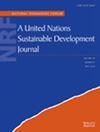Sustainable development in ASEAN: The role of trade diversification, government revenue, and natural resources
IF 3.7
4区 社会学
Q2 ENVIRONMENTAL SCIENCES
引用次数: 0
Abstract
Over the past few years, the Association of Southeast Asian Nations (ASEAN) has experienced great economic expansion, which has resulted in varied degrees of diversified commerce, an elevated level of government revenue, and an increase in the demand for energy. The purpose of this study is to provide a solution to this conundrum by analyzing the effects of trade diversification (TDF), government revenues (GRN), gross domestic product (GDP), and natural resource rent (NTR) on the sustainable development of the ASEAN countries between the years 1981 and 2022. In order to accurately portray the concept of environmental sustainability, the ecological footprint (EFP) is utilized to represent sustainable development. The quantile‐based econometrics technique known as the Method of the Moments Quantile Regression (MMQR) has been utilized in order to investigate the direction and amplitude of the asymmetric correlation that exists between the interaction of GRN, TDF, NTR, and EFP. According to the estimations of the MMQR, it is proposed that government revenues, which include significant financial incentives that promote the stringent execution of environmental rules, hence avoiding deleterious impacts on the environment, have negative coefficients at all quantiles (Q东盟的可持续发展:贸易多样化、政府收入和自然资源的作用
在过去几年中,东南亚国家联盟(东盟)经历了巨大的经济扩张,这导致了不同程度的商业多样化、政府收入水平的提高以及能源需求的增加。本研究旨在通过分析 1981 年至 2022 年间贸易多元化(TDF)、政府收入(GRN)、国内生产总值(GDP)和自然资源租金(NTR)对东盟国家可持续发展的影响,为这一难题提供解决方案。为了准确描述环境可持续发展的概念,采用了生态足迹(EFP)来表示可持续发展。为了研究 GRN、TDF、NTR 和 EFP 之间交互作用的非对称相关性的方向和幅度,使用了基于量子计量经济学的矩量回归方法(MMQR)。根据 MMQR 的估计结果,政府收入在所有量级(Q0.25 - Q0.90)都具有负系数,其中包括促进严格执行环境规则从而避免对环境造成有害影响的重要财政激励措施。相反,TDF 和 GDP 在所有量级(Q0.25 - Q0.90)上都具有统计意义上的显著正相关性,这表明 TDF 降低了环境的可持续性,并通过使能源密集型产品更容易获得而扩大了世界 EFP 的规模。此外,增强均值组(AMG)和共同相关效应均值组(CCEMG)都提供了支持相关性研究的证据,表明各变量之间存在相似的因果关系模式。
本文章由计算机程序翻译,如有差异,请以英文原文为准。
求助全文
约1分钟内获得全文
求助全文
来源期刊

Natural Resources Forum
环境科学-环境科学
CiteScore
6.10
自引率
0.00%
发文量
24
审稿时长
>36 weeks
期刊介绍:
Natural Resources Forum, a United Nations Sustainable Development Journal, focuses on international, multidisciplinary issues related to sustainable development, with an emphasis on developing countries. The journal seeks to address gaps in current knowledge and stimulate policy discussions on the most critical issues associated with the sustainable development agenda, by promoting research that integrates the social, economic, and environmental dimensions of sustainable development. Contributions that inform the global policy debate through pragmatic lessons learned from experience at the local, national, and global levels are encouraged.
The Journal considers articles written on all topics relevant to sustainable development. In addition, it dedicates series, issues and special sections to specific themes that are relevant to the current discussions of the United Nations Commission on Sustainable Development (CSD). Articles must be based on original research and must be relevant to policy-making.
Criteria for selection of submitted articles include:
1) Relevance and importance of the topic discussed to sustainable development in general, both in terms of policy impacts and gaps in current knowledge being addressed by the article;
2) Treatment of the topic that incorporates social, economic and environmental aspects of sustainable development, rather than focusing purely on sectoral and/or technical aspects;
3) Articles must contain original applied material drawn from concrete projects, policy implementation, or literature reviews; purely theoretical papers are not entertained.
 求助内容:
求助内容: 应助结果提醒方式:
应助结果提醒方式:


